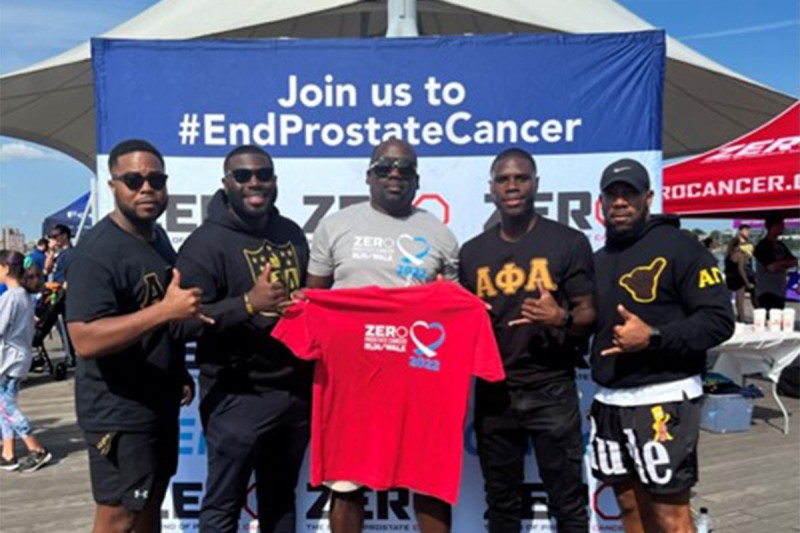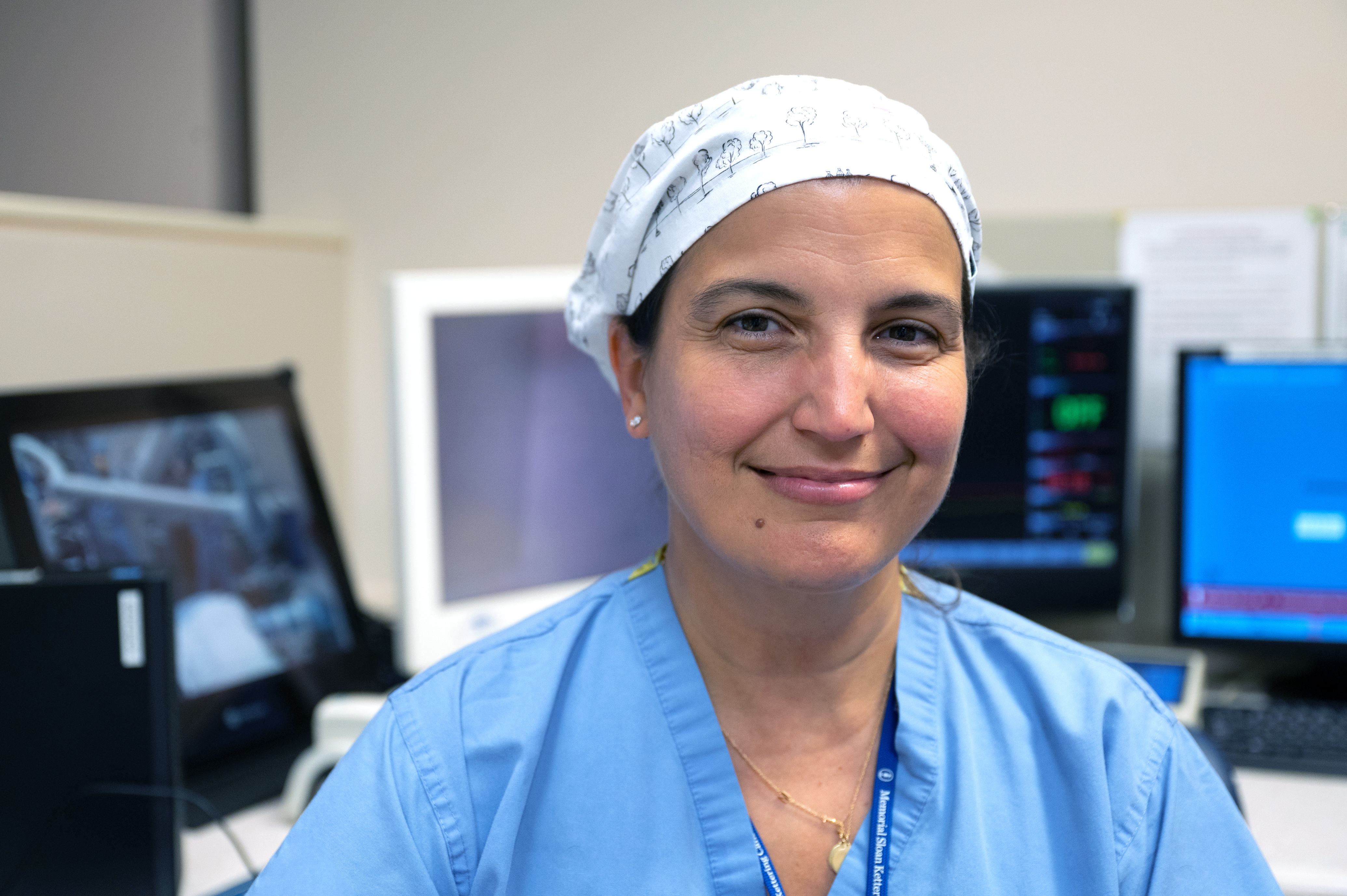
Larry Scott Blackmon, center, was treated for prostate cancer at MSK and helps raise awareness about the need for screening among Black men. In September 2022, he participated in the ZERO Prostate Cancer Run/Walk in Manhattan with fellow members of the Alpha Phi Alpha fraternity and was one of the top fundraisers.
-
Prostate cancer takes a severe toll on Black men.
- Prompt diagnosis and treatment is especially important for good outcomes.
Larry Scott Blackmon was stunned when actor Chadwick Boseman passed away from colon cancer in August 2020. Several months later, Larry’s annual checkup revealed a high prostate-specific antigen (PSA) level — a marker of prostate cancer. He took that PSA test seriously. Seeing the charismatic actor get taken down by cancer at age 43 — slightly younger than Larry at the time — was a wake-up call.
A vice president of Fresh Direct and leader in the Harlem and Black political community, Larry did not hesitate to follow up with a urologist, even in the middle of the COVID-19 pandemic.
“A challenge for men of color is paying attention to their health and screening for things like prostate cancer,” he says. “I was determined to go into the doctor’s office and ask for more testing.”
Black Men Have an Increased Prostate Cancer Risk
Larry had good reason to be concerned about getting prompt diagnosis and treatment. Prostate cancer has increased steadily over the last decade, according to a 2023 report from the American Cancer Society. This increase was driven by the diagnosis of advanced disease, which has gone up by 4% to 5% annually. The proportion of men diagnosed with prostate cancer that has spread to other parts of the body – making it more difficult to treat — has actually doubled.
In addition, prostate cancer takes a harsher toll on Black than other American men, including other men of color. Black men are 1.7 times as likely to develop prostate cancer in their lifetime and 2 to 4 times as likely to die from the disease, compared with other racial and ethnic groups.
The reasons for the disparity are complex and not fully understood. The increased prostate cancer risk for Black men may be related to:
- Social disparities — such as access to healthcare
- Environmental issues — such as exposure to carcinogens
- Differences in tumor biology that cause prostate cancer in Black men to progress faster or be harder to treat
Larry had an MRI scan and biopsy, which showed he had intermediate-risk prostate cancer.
“I was devastated. I just didn’t understand it,” he says. “I was thinking: ‘Am I going to die young? What does this mean for me in terms of quality of life?’ ”
Deciding on Prostate Cancer Treatment in New York City
Larry’s brother urged him to go to Memorial Sloan Kettering Cancer Center (MSK) because his girlfriend had been treated there for breast cancer. Larry contacted MSK and had an evaluation with radiation oncologist Daniel Shasha, MD. He says Dr. Shasha immediately put him at ease.
“He looked at my chart and said, ‘You will be cured,’ ” Larry recalls. “Those were the most reassuring words I had ever heard.”
Relieved that his outlook was favorable, Larry was also glad he had a choice of surgery or radiation to treat his disease. His form of prostate cancer would grow slowly, so he had time to weigh his options and consider the side effects of either treatment. He met with MSK urologic surgeon Alvin C. Goh, MD, about a possible operation but worried about radical prostatectomy side effects such as sexual dysfunction and urinary problems.
“Dr. Shasha had been very upfront and direct about pros and cons of each treatment and how they affect quality of life,” Larry says. “I also talked to a lot of other Black men who had been through prostate cancer treatment. Based on what they told me, I leaned toward radiation.”
Radiation for Prostate Cancer
Larry met with MSK radiation oncologist Marisa A. Kollmeier, MD, who specializes in radiation therapy for prostate cancer.
“She was nothing short of incredible,” Larry says.
Dr. Kollmeier explained that he had two radiation treatment options:
- External beam radiation therapy — typically an approach called MSK Precise®, which destroys tumors with a high, targeted dose of radiation in fewer sessions than traditional long-course radiation therapy.
- Brachytherapy — an internal form of radiation therapy, pioneered for prostate cancer at MSK, in which radioactive seeds are implanted into the tumor/prostate and destroy it.
“For a patient with favorable-risk prostate cancer, the choice of treatment is usually guided by patient preference regarding side effect comparisons,” Dr. Kollmeier says. “Larry selected brachytherapy because of the excellent efficacy and preferable side effect profile for his lifestyle.”
How Brachytherapy Cures Prostate Cancer With Radioactive Seeds
In November 2021, Larry received brachytherapy treatment at MSK’s main hospital. Dr. Kollmeier implanted tiny titanium seeds containing radiation through needles placed into the skin and directly into the prostate during an hourlong procedure while Larry was under anesthesia. To enable precise seed placement, she used transrectal ultrasound guidance and a sophisticated computer software treatment planning system. This ensured that the tumor received the optimal dose of radiation while the surrounding tissue was protected.

Radiation oncologist Marisa Kollmeier
“The precision of seed placement directly into the prostate enables us to deliver a high dose exactly where it needs to be, reducing the dose to normal surrounding tissue such as the rectum, bladder, and erectile tissues,” Dr. Kollmeier says. “We also take a final MRI scan before the patient is discharged to ensure the seeds remain at the ideal locations.”
Larry was able to go home later the same day. He felt the effects of the operation for about a month, mainly soreness and fatigue. “It takes time for the prostate to heal and for your body to recover, and I dealt with fatigue for some time,” he says. “But I am past that now.”
Back to an Active Life After Brachytherapy
Two years after treatment, Larry continues to be fully active, enjoying baseball and basketball — and, above all, bicycling. In May 2022, he completed the TD Five Boro Bike Tour, a 40-mile ride around New York City. He also is a part-time professional DJ.
Larry is well-known in the Harlem and Black political community and was named a Crain’s New York Business Notable Black Leader in 2022. He has started his own consulting firm, The Blackmon Organization. He also works closely with a long list of civic organizations, including the Alpha Phi Alpha fraternity and 100 Black Men of New York, and with City Harvest, a nonprofit that helps alleviate food insecurity.
He also has become a strong advocate for prostate cancer awareness. In September 2022, he participated in the ZERO Prostate Cancer Run/Walk in Manhattan and was one of the top fundraisers. He urges other Black men to get screened for the disease.
“Dr. Shasha told me that he’s seen more and more younger Black men who are coming in with prostate cancer,” Larry says. “He encouraged me to tell my story and not be shy about it, so I’m putting myself out there.”
His message to others: Don’t let fear of cancer stop you from taking care of yourself.
“For anyone recently diagnosed with prostate cancer, I want you to know your life is not over,” he says. “The first thing is stay strong. If you catch it early, it can be cured. The second thing I’ll say is speak up. You do not have to suffer in silence. Rely on your faith, rely on loved ones, and rely on the great support team, such as the folks from Memorial Sloan Kettering to get you through it. God gave me a second chance in life, and I am eternally and forever grateful.”
This story was originally posted in 2022 and has been updated.




